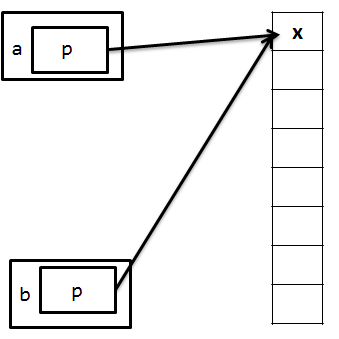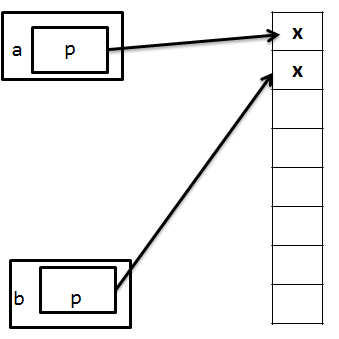构造函数 拷贝构造函数
Posted lykkk
tags:
篇首语:本文由小常识网(cha138.com)小编为大家整理,主要介绍了构造函数 拷贝构造函数相关的知识,希望对你有一定的参考价值。
什么是拷贝构造函数
拷贝听起来真高级
拷贝构造函数形如
class_name(const class_name &object_name)拷贝构造函数是一种特殊的构造函数,只有一个参数,这个参数是本类中的一个对象,以引用的形式传参,一般用const修饰,使参数值不变。
如果没有定义拷贝构造函数,编译器会自动隐式生成一个拷贝构造函数,用来简单的复制类中每个成员变量。
一个简单的类对象拷贝
#include <bits/stdc++.h>
using namespace std;
class A {
private :
int a, b;
public :
A(int x, int y) : a(x), b(y) {}
void print() {
printf("%d %d\n", a, b);
}
};
int main() {
A a(10, 20);
A b = a;
b.print();
return 0;
}输出
10 20
具体看一下拷贝构造函数怎么用。
#include <bits/stdc++.h>
using namespace std;
class A {
private :
int a, b;
public :
A(int x, int y) : a(x), b(y) {}
A(const A &c) {
a = c.a;
b = c.b;
}
void print() {
printf("%d %d\n", a, b);
}
};
int main() {
A a(10, 20);
A b = a;
b.print();
return 0;
}这样手动的写如何复制
为什么要引用
为什么用引用的方式传参呢。
举个反例
#include <bits/stdc++.h>
using namespace std;
class A {
private :
int a;
public :
A(int x) : a(x) {}
A(const A c) {
a = c.a;
}
void print() {
printf("%d\n", a);
}
};
int main() {
A a(10);
A b = a;
b.print();
return 0;
}A b = a时,调用了传值型的拷贝构造函数,
相当于b.A(a),
因为是传的值,所以要用a的值创建一个副本对象c,让c的值为a,则又需要调用构造函数c.A(a),这样会无限创造副本对象c,无限调用c.A(a);
所以
引用是为了防止无限递归。
其实没有加引用的话编译器也是不过编译的。
拷贝构造函数的调用时机
1. 对象需要通过另一个对象对其进行赋值
A a(10, 20);
A b = a;2. 当函数的参数是类的对象
#include <bits/stdc++.h>
using namespace std;
class A {
private :
int a, b;
public :
A(int x, int y) : a(x), b(y) {}
A(const A &c) {a = c.a, b = c.b;}
void print() {printf("%d\n", a * b);}
};
void fun(A c) { //函数的形参是类的对象
c.print();
}
int main() {
A a(10, 20);
fun(a); //实参是类的对象,调用函数时将复制一个新对象c
return 0;
}3. 当函数的返回值是类的对象
#include <bits/stdc++.h>
using namespace std;
class A {
private :
int a, b;
public :
A(int x, int y) : a(x), b(y) {}
A(const A &c) {a = c.a, b = c.b;}
void print() {printf("%d\n", a * b);}
};
A fun() {
A b(20, 10);
return b; //函数的返回值是类的对象
}
int main() {
A a = fun(); //fun()返回 A 类的临时对象,并赋值给a
a.print();
return 0;
}深拷贝和浅拷贝
默认拷贝构造函数可以完成对象的数据值得简单复制,这就是浅拷贝。
对象的成员是指向堆时,浅拷贝只是将指针简单复制一遍,指向了原有的内存,而深拷贝是将新建的指针指向了一块新的内存。
浅拷贝
浅拷贝就是将数据简单复制一下,就像上面讲的。
看这段代码
#include <bits/stdc++.h>
using namespace std;
class A {
private :
int *p;
public :
A(int x) {
p = new int(x);
printf("Constructor\n");
}
A(const A &oth) {
this->p = new int(*oth.p);
printf("Constructor\n");
}
~A() {
if (p != NULL) delete p;
printf("Destructor\n");
}
void print() { printf("%d\n", *p); }
};
int main() {
A a(10);
A b = a;
return 0;
}这是段代码出错了,为什么?
如图所示,

b把a的指针简单复制了一遍,两者都指向了同一块内存,释放内存的时候被释放了两次,导致出错。
深拷贝
对于上面的代码,我们手写一个拷贝构造函数,像这样
#include <bits/stdc++.h>
using namespace std;
class A {
private :
int *p;
public :
A(int x) {
p = new int(x);
printf("Constructor\n");
}
A(const A &oth) {
this->p = new int(*oth.p);
printf("Constructor\n");
}
~A() {
if (p != NULL) delete p;
printf("Destructor\n");
}
void print() { printf("%d\n", *p); }
};
int main() {
A a(10);
A b = a;
return 0;
}我们给b初始化时,给它新开辟了一段内存空间

这样,深拷贝就没有上述浅拷贝时内存释放两次的情况了。
以上是关于构造函数 拷贝构造函数的主要内容,如果未能解决你的问题,请参考以下文章